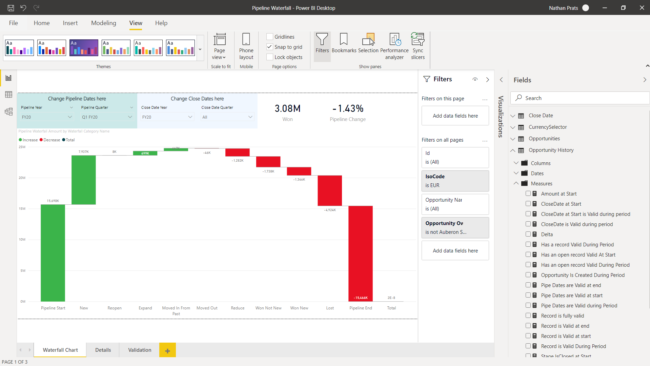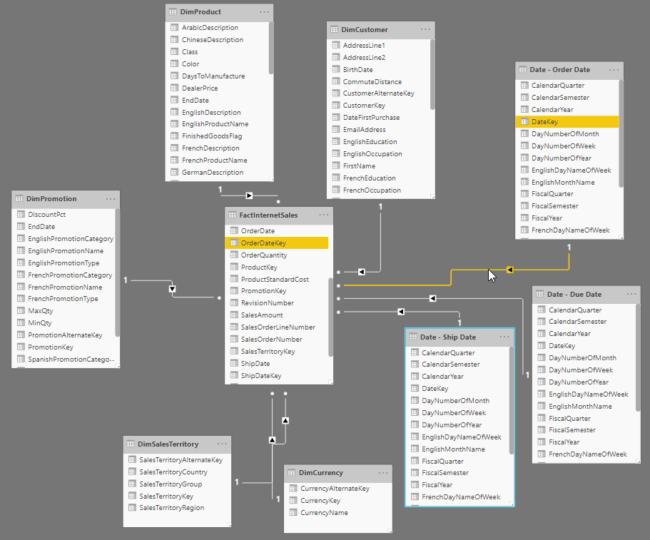Revenue Operations
Welcome to my Revenue Operations blog, where I organized articles in the 3 essential pillars of Revenue Operations:
- Strategy – We explore innovative approaches and frameworks to align your revenue-generating teams, ensuring cohesive and strategic growth.
- Insights – Data-driven decision-making is at the heart of success. Discover the latest trends, analytics, and actionable insights that will drive your business forward.
- Systems – Streamline your operations with the best tools and processes designed to enhance productivity and drive revenue.
Building a Powerful Pipeline Waterfall Dashboard with Power BI: Unleashing Insights and Customization The pipeline waterfall report is one of the advanced visuals the sales department can benefit from. Sales Operations often get access to this analysis through third-party forecasting software companies. However, it’s not uncommon to have data issues with this visual. In another…
Details
From DAX to SQL: Replicating the Essential Date Table for BI Developers Having a date table is not optional when it comes to Business Intelligence. When building data models, it’s actually the first table I’m adding most of the time. Why using a date table? As a BI developer, I need to filter different dates…
Details
Learning Python with a Nostalgic Twist: Building the ‘Satellite Game’ from Jak 3 This is a non data-related article. However, learning Python might be helpful to master for future data projects, especially when it comes to Data Science. Python has great data related libraries such as Pandas, Seaborn and Matplotlib. They can be used in…
Details
As a data modeler, you need to understand the “one or many date tables” dilemma. You don’t want having to switch from one option to another after a few weeks of development, as it’d be a painful change to go through. In this post, I’ll try to give you a clear overview of these two…
Details
Building Effective Hierarchy Structures in Power BI Organizational hierarchy or account mapping adds complexity to reporting. Being able to work with it with basic reporting tools like Salesforce report is impossible. For example, if your company sells to big customers with hundreds of subsidiaries, chances are that account mapping is quite important for your selling…
Details
Forecasting Sales Run Rate: Leveraging Historical Performance for Accurate SaaS Projections A run rate is a forecast based on current performance. For SaaS companies, this metric is interesting to compute as their future performance is highly influenced by the actual ARR of the company. For example, if a company sells yearly subscriptions, the sales “seasonality”…
Details
Users often need to see the data in different angles to find the business insights they’re looking for. Instead of creating dozens of visuals in your reports, solutions exist to reduce the number of visuals while giving users control over it. In this post, I’ll detail 4 different ways to achieve this, and I’ll discuss…
Details
Applying the Pareto Principle: Categorizing Products for Sales Analysis in Power BI The Pareto principle says that about 80% of the effects come from 20% of the causes. In this article, I’ll create a Power BI measure to rank products from Adventure Works into 4 categories, to show that a few products represent most of…
Details
A Beginner’s Guide to Business Intelligence: Access, Clean, Organize, and Present Data with Power BI Getting started with business intelligence is easy. In this post, I’ll share a few steps to follow to get access to data, start building a data model and create a report in a client application like Power BI. To do…
Details
If you’re familiar with Salesforce, you know that customizing it to fit your SaaS company metrics can be challenging. For SaaS forecasting, the default field Salesforce utilizes is the Amount field on the Opportunity object. In this post, I’ll explain why you shouldn’t use the amount field for forecasting, and how you can forecast properly…
Details


